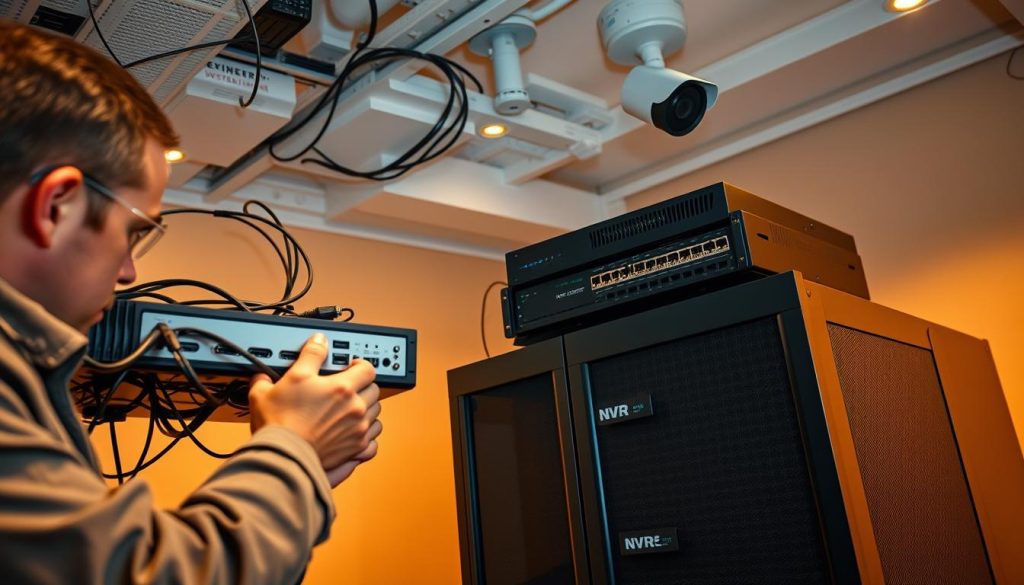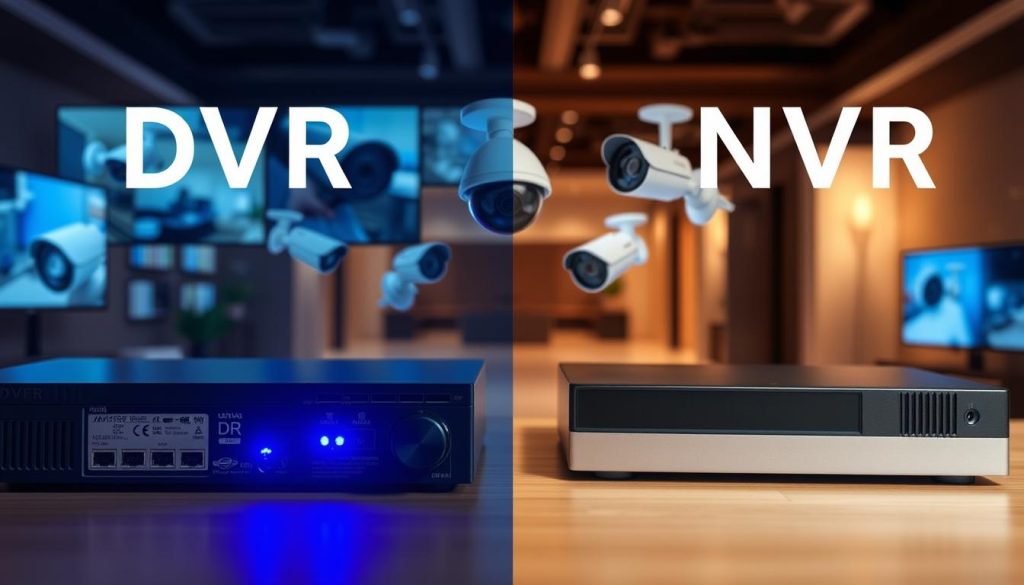In today’s world, knowing the difference between DVR and NVR is key. Both Digital Video Recorders (DVR) and Network Video Recorders (NVR) are important for recording video. But they work in different ways.
DVR systems change analog footage into digital formats. This makes them good for older camera tech. On the other hand, NVR systems handle only digital footage. This lets them use more advanced image processing.
This difference is important in Singapore, where modern security systems are in high demand.
Key Takeaways
- DVR systems convert analog signals into digital format.
- NVR systems work exclusively with digital footage.
- Understanding the systems helps tailor security needs.
- DVR is typically suited for older camera technologies.
- NVR provides advanced image processing features.
- Choosing the right system optimizes costs and maintenance.
Understanding DVR Systems
DVR systems, or digital video recorders, are key in security and surveillance. They capture video from analog cameras. Knowing how DVRs work can make your surveillance better.
What is a DVR?
A DVR is a device that records video from analog cameras. It changes the video into digital format for easy storage and access. DVRs are made for analog cameras, using coaxial cables for connections.
How DVR Systems Work
DVRs work by converting analog camera footage into digital. They use coaxial cables to connect to cameras. Each camera needs its own power source and video cable.
This setup can make installation tricky. It limits how far and flexible the cables can be.
Understanding NVR Systems
NVR systems, or network video recorders, are a new way to watch over places. They are different from old DVRs because they work with IP cameras. Knowing about NVRs helps people and businesses pick the right security tools.
What is an NVR?
An NVR is a device that records and manages video from IP cameras. It captures and plays back video in high quality. This makes surveillance systems work better.
NVRs can handle many high-definition streams from different places. They are now the top choice for modern surveillance.
How NVR Systems Function
NVR systems process video data right at the camera before sending it to the recorder. This improves video quality and cuts down on cabling needs. Footage can travel over the internet, making it easy to watch from anywhere.
Using IP cameras with NVRs brings many benefits for watching over places. For more info, check out this comparison of DVR and NVR.
What is the difference between DVR and NVR?
DVR and NVR systems differ mainly in how they handle video, the cameras they support, and their setup needs. DVRs use coaxial cables and work with analog cameras. They need separate power for each camera, making setup more complicated.
NVR systems, on the other hand, use Ethernet cables and IP cameras. These cameras process video data themselves. This makes installation easier because one cable can carry both power and data. Users get better video quality and more remote monitoring options.
When comparing DVR and NVR, we also see differences in storage. DVRs store footage on local hard drives. NVRs offer cloud storage, giving users more flexibility. Knowing these differences helps people choose the right system for their needs.
Components of DVR Systems
Knowing the key parts of a DVR system is important for a good surveillance setup. Different parts work together to make a system that works well. We’ll look at three main parts: analog cameras, coaxial cables, and the AD encoder.
Analog Cameras
Analog cameras are a big part of DVR systems. They are easy on the wallet and simple to use. Even though they don’t have the best video quality, they are a good choice for basic needs.
Coaxial Cables
Coaxial cables are key for linking analog cameras to the DVR. They send video well but can’t power the cameras. So, you need a different power source. These cables can go up to 90 meters, but longer distances can hurt the video quality.
AD Encoder Role
The AD encoder is very important in a DVR system. It changes the analog signals from cameras into digital video. Each camera needs its own wire to the DVR, which can be tricky. But, the AD encoder makes sure the system works right, helping with surveillance.
Components of NVR Systems
Knowing the key parts of NVR systems is key for good surveillance. The main NVR system components are IP cameras and Ethernet cables. Both are important for how well the system works and how easy it is to set up.
IP Cameras
IP cameras are essential for NVR systems. They can handle and send video data on their own. This lets them send high-quality video straight to the NVR.
They do more than just record video. Most can also capture audio and have smart analytics. This makes surveillance better.
Ethernet Cables
Ethernet cables connect IP cameras to the NVR. They make setting up the system much easier. With Power over Ethernet (PoE), they carry both data and power.
This makes setting up NVR systems simpler. It lets them work well in many different places.
Pros and Cons of DVR Systems
DVR systems are a favorite among those looking for surveillance solutions. Knowing the DVR pros and cons helps you decide. Each point gives you insight into the benefits and drawbacks of DVR systems.
Advantages of DVR
DVR systems are affordable, which is a big plus. They fit well with older camera setups, saving you money. This makes them a smart choice for many users. Other benefits include:
- Wide availability of compatible analog cameras.
- Simple user interfaces for ease of operation.
- Good options for local storage and system management.
Drawbacks of DVR
Despite their benefits, DVR systems have some downsides. They use coaxial cables, which can be hard to install in tight spaces. Also, the video quality is often lower than what IP cameras offer. Other drawbacks include:
- Limited flexibility in camera placement compared to IP systems.
- Challenges in scaling up due to wiring limitations.
For more information on DVR and NVR systems, check out this resource here.
Pros and Cons of NVR Systems
NVR systems are becoming more popular for their strong security features. They are favored by businesses and homeowners alike. Knowing the good points of NVR helps users make better choices. It’s also important to understand its limitations to see if it meets your needs.
Advantages of NVR
NVR systems use IP cameras, which provide better video quality than old methods. The main benefits are:
- Remote Access: You can watch your system from anywhere with internet.
- Audio Recording Features: They can record sound along with video.
- Flexible Installation: They fit many layouts, making wiring easier.
Limitations of NVR
Even with many good points, NVR has some downsides. Important drawbacks are:
- Higher Initial Costs: Setting up NVR can cost more at first.
- Software and Compatibility Challenges: Integrating different devices can be tricky.
- Reliance on Internet Connectivity: This makes systems vulnerable to cyber threats.
Cost Comparison between DVR and NVR
When looking at security systems, it’s important to think about the cost upfront and what it will cost later on. A detailed comparison of DVR and NVR systems helps buyers make the right choice for their needs.
Initial Investment
The cost at the start is a big factor in choosing a system. DVR systems are often cheaper to buy. This is because they use analog cameras and simpler technology. On the other hand, NVR systems cost more because they use advanced technology and IP cameras.
Buyers need to consider their budget and what they need for their project.
Long-term Maintenance Costs
Buying a security system is not just about the initial cost. The cost of keeping it running over time is also key. NVR systems might cost more to maintain because of software updates and compatibility issues. DVR systems, though, tend to be cheaper to keep up with, needing fewer updates.
Knowing these costs helps ensure that a security system is affordable and effective in the long run.
Installation Differences between DVR and NVR
It’s important to know how DVR and NVR systems are installed. Each system has its own setup needs and challenges. This can help you choose the best security option for you.
Wiring Requirements
DVR systems need coaxial and power cables for each camera. This makes installations more complicated. You have to run extra cables to each camera spot.
NVR systems, though, use Ethernet cables. This makes setup easier. With Power over Ethernet (PoE), you only need one cable for power and data. This simplifies the installation a lot.
Setup Complexity
DVR installations can be tricky because you need to connect each camera directly. This makes the setup more complex.
NVR installations are easier. You can place cameras anywhere because they connect through your network. This makes setting up your system simpler.

Video and Audio Quality in DVR vs. NVR
It’s important to know how DVR and NVR systems differ in video and audio quality. This helps you choose the right security solution. We’ll look at how each system handles video and audio, helping you make a smart choice.
Video Signal Processing
DVR systems use analog signals, which can limit their video quality, mainly over long distances. As distance grows, signal quality drops. On the other hand, NVR systems process video digitally at the camera, leading to clearer images.
This digital method ensures better video quality. It’s perfect for large areas where distance is a problem.
Audio Transmission Capabilities
When comparing audio quality, it’s key to look at each system’s audio transmission. DVR systems often struggle with audio and may need extra connections. This can make installations harder and more expensive.
NVR systems, though, can send audio over Ethernet easily. Cameras with microphones can capture sound well. This makes the system simpler and more efficient, making it easier to integrate video and audio.
Choosing the Right System for Your Needs
When picking the best security for your place, knowing the difference between DVR and NVR systems is key. Each has its own benefits, and what you choose depends on what you need. Think about what cameras you have and your budget. These things really matter when deciding.
If you have old cameras and want something simple and cheap, a DVR might be good. But, if you want to be able to watch your cameras from anywhere, high-quality video, and smart features, an NVR is better. NVRs are great for big setups because they can grow with you and work with IP cameras.
When choosing, think about what you really need and how much you can spend. For basic security, a DVR might be enough. But, if you want top-notch surveillance, an NVR could be worth the extra cost. Thinking about these points will help you make a smart choice for your security.

